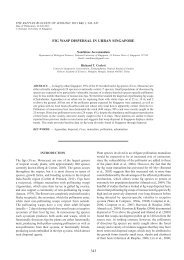1O257LF
1O257LF
1O257LF
You also want an ePaper? Increase the reach of your titles
YUMPU automatically turns print PDFs into web optimized ePapers that Google loves.
© 2010 Dinosauria International Ten Sleep Report Series No. 1<br />
Sauropodomorph incertae sedis. However, if the holotype<br />
can be shown to be part of a more complete individual with<br />
definable specific diplodocid characters, then the genus<br />
name Apatosaurus may have priority over Amphicoelias. But<br />
as a fragmentary sacrum the type can only be judged nomen<br />
dubium.<br />
Fig 29 Illustration of AMNH 223 after Osborn 1900, in this study<br />
referred to Amphicoelias altus, exhibits elongated prezygapophyses<br />
not seen in A. “brontodiplodocus”.<br />
long quadrate from Quarry 10, places this cranial material<br />
outside the size range of the holotype sacrum. In comparison<br />
with the sacrum belonging to the type of A. lousiae, the<br />
quadrate would represent an individual approximately half<br />
the size. The size of the quadrate in the “probable skull”<br />
belonging to A. lousiae, is 18.5 cm (7.28 inches) . According<br />
to Ostrom and McIntosh (1966), Quarry 10 has produced<br />
the remains of three sauropod skeletons – Atlantosaurus<br />
immanis, Apatosaurus laticollis and A. ajax. So, it does not<br />
seem possible that the holotype of A. ajax can ever be sorted<br />
reliably. Furthermore, it is not clear if the collection from<br />
Quarry 10 belongs to one taxon or a mixture.<br />
Apatosaur cervical vertebrae and limbs are often<br />
mistaken for bones of Camarasaurus, and vice versa, which<br />
may be the case in the type of A. ajax. A point of similarity<br />
between Camarasaurus and the type of A. ajax has not been<br />
addressed. The illustrations in Marsh 1896 of D. longus<br />
(pl xxv111), Morosaurus lentus (pl XXX111), Atlantosaurus<br />
montanus (pl XV11), and Ostrom & McIntosh (1966) of A.<br />
amplus YPM 1981 type, Brontosaurus excelsus YPM 1980, and<br />
Morosaurus grandis YPM 1900, reveal an interesting disparity<br />
in the relative proportional lengths of S 2 and S 3 against S<br />
4 in the sacrum. Other differences include the ventral shape<br />
of the centra, which are broadly rounded in Camarasaurus in<br />
contrast to the distinct keeling in specimens referred to as<br />
Diplodocus. In “Morosaurus”, S 2-4 are nearly equal in overall<br />
size and ventral lengths, whereas, in the other specimens S<br />
4 is proportionately larger compared with the adjoining S<br />
2 - S 3. The holotype of A. ajax YPM 1860 is more similar<br />
to Camarasaurus (Morosaurus) in this aspect. Furthermore,<br />
Marsh (1877) stated that both type specimens of A. ajax and<br />
Camarasaurus (Morosaurus) grandis originated from the same<br />
locality. Thus, reexamination is urgent. The type needs to be<br />
compared and described properly to resolve these issues.<br />
The taxonomic status of A. ajax can be presently considered<br />
Notwithstanding the taxonomic status of<br />
Apatosaurus ajax, the description of the genus essentially<br />
rests on two specimens, the holotype skeleton of Apatosaurus<br />
louisae (Holland 1915) and the mounted skeleton of<br />
Brontosaurus excelsus (Como Bluff, YPM 1980 and YPM 4633).<br />
A. louisae is by far the most widely acclaimed example and<br />
is on exhibit at the Carnegie Museum of Natural History.<br />
The B. excelsus skeleton is mounted and exhibited at the<br />
Yale Peabody Museum. Despite the familiarity of these<br />
Apatosaurus specimens, various aspects of the skeleton<br />
remain poorly known, particularly the cervical vertebrae.<br />
Riggs (1903) and Upchurch et al (2004b) have described<br />
reasonably complete specimens, but in these specimens<br />
the cervical series are as incomplete and fragmentary as<br />
the Peabody and American Museum B. excelsus skeletons.<br />
In fact, the cervical vertebrae which form part of the type<br />
of A. louisae, were not found directly articulated to the<br />
dorsals and may have been from a different individual.<br />
Moreover, the posterior vertebrae C 13-15 are badly crushed<br />
and modeled plaster reconstructions are mounted on the<br />
skeleton and illustrated in Gilmore’s (1936) description.<br />
Proportions and lack of certain diplodocid details, e.g.,<br />
a transverse central buttress (Berman and Rothschild<br />
2005), gives more the impression of a camarasaurid than a<br />
diplodocid morphology. It should be pointed out that these<br />
cervical vertebrae were reconstructed during a time when<br />
ideas of Morrison sauropod relationships were vague and<br />
not widely accepted, so the reconstruction may be incorrect.<br />
It is not possible to judge the length of C 14 against C 15<br />
and the relation to the first dorsal. Verification of an anterior<br />
rib process is also lacking. As a result, generic and species<br />
level diagnoses remain vague particularly in the cervical<br />
region. Another feature indicating that the cervicals may be<br />
incorrectly reconstructed and misleading is the noticeably<br />
short centrum length of C 14 in A. louisae. Comparisons with<br />
specimens preserving the required articulation show that<br />
the 14 th cervical vertebra is the longest in the series and is<br />
an Amphicoelias synapomorphy. If the cervicals are correctly<br />
reconstructed in A. louisae then it is suspect whether they<br />
belong to one individual or represent an aberrant form<br />
that displays an abnormal cervical skeleton. An aberrant<br />
individual is suggested by the odd fact that no other skeleton<br />
preserving similar associated cervicals has been reported<br />
belonging to A. louisae.<br />
Osborn & Mook (1921) observed little difference<br />
in the cervical vertebrae between Camarasaurus and<br />
Apatosaurus, which may have led to reconstructing the<br />
34



